 |
| |
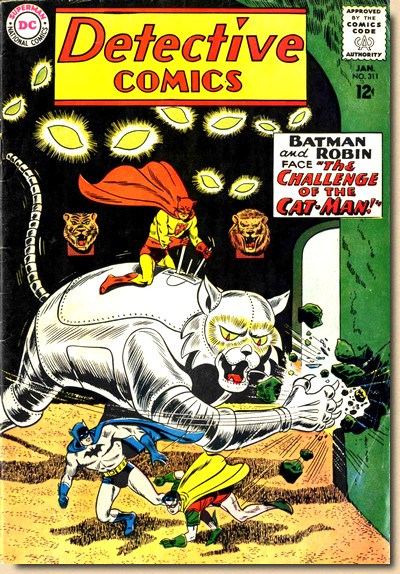 |
|
DETECTIVE
COMICS #311
(JANUARY
1963)
BATMAN
& ROBIN FACE THE
"CHALLENGE
OF THE CAT-MAN!"
(12 2/3
pages)
Cover
pencils - Dick Dillin
Cover inks - Sheldon
Moldoff
Story - Bill
Finger
Art - Jim Mooney
Inks - Jim Mooney
Colours - NN
Lettering - NN
Second
feature
John Jones Manhunter from Mars, "The
Invaders from the Space Warp!"
(11 2/3 pages)
|
|
|
| |
PLOT SUMMARY
"BEWARE
OF BLACK CATS -- THEY BRING BAD LUCK !
AN OLD SUPERSTITION, BUT ONE THAT COMES TRUE FOR BATMAN AND ROBIN !
YES, THE CAPED MANHUNTERS ARE INDEED PLAGUED BY A CAT
-- A CAT IN HUMAN FORM,
WHO MOVES WITH CAT-LIKE CUNNING THROUGH THE NIGHT, TO
CLAW AND PLUNDER EVERYWHERE !
THEN, AT BAY, HE ALMOST DOOMS BATMAN AND ROBIN IN A
DEADLY CAT-AND-MOUSE GAME
THAT CLIMAXES THE... CHALLENGE
OF THE CAT-MAN !"
|
| |
| After foiling a
robbery together with Robin, Batman
decides to do something for his public
persona and pays a visit to his social
club as Bruce Wayne, where he meets Tom
Blake, the famous "Cat-Master".
Blake tells Wayne
that he has retired from big game hunting
because he found it had become boring as
he knew all the ways of the wild animals
in advance, and so two seemingly bored
socialites (although Bruce Wayne, of
course, is only putting on a show) sit
out a yawnful evening.
Later, back at his
animal farm, Tom Blake is haunted by a
jest a fellow club member made concerning
the one person in Gotham who would never
get bored - Batman. Blake ponders the
possibilities of becoming a crimefighter
but quickly reaches the conclusion that
there can only be one like Batman - so
his second thoughts thus turn to the
possibility of becoming Batman's
adversary, and Blake feels a rush of
excitement he has not known for years.
However, he feels he
should be a "unique criminal,
like the Joker -- my crimes must have a
theme!" Seeing his pet black
panther reminds Blake of Cat-Woman, and
convinced that he can be a far more
formidable threat to Batman than Cat-Woman
ever was, he decides that he will become
the Cat-Man...
|
|
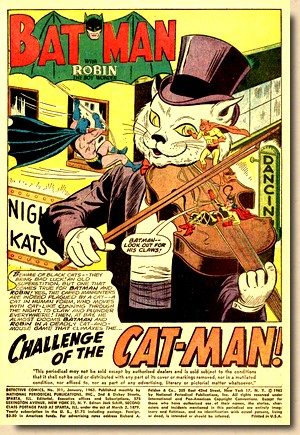 |
|
|
| |
| A week
later, Batman is a guest of honour at the opening of
Gotham Museum's new Egyptian exhibition wing. Just as the
guide elaborates on Bast, the ancient Egyptian cat
goddess, a masked figure clad in yellow and orange bursts
onto the scene - the Cat-Man. Grabbing the precious Bast
statue exhibit, Cat-Man makes a run for it. Batman holds
back Robin, warning him that the suit of the thief
features sharp claws, and Cat-Man makes an escape through
a window. Outside the museum, Cat-Man takes
flight in his car which is fashioned with a cat's head
and tail and even features, as Batman remarks, a motor
which purrs like a cat. Following him down an abandoned
road the Caped Crusader and the Boy Wonder become witness
to the fact that the Cat-Man's car can even make short,
cat-like jumps thanks to special springs. Cat-Man leaves
the Dynamic Duo behind making a remark about sweet music
which he hopes to hear tomorrow at nine o'clock.
Later in the
batcave, residues of calcium phosphate on Robin's cape
where the Cat-Man's claws struck lead Batman to guessing
who might be under the mask of Cat-Man, as the substance
is commonly put on meat fed to large cats in zoos. At the
same time, Blake returns to his animal farm which he has
now set up as a complex hiding place for his supervillain
activities, and he wonders if he really just turned to
crime out of boredom or whether his motive might not
actually be to regain the wealth he has lost.
Back at the
social club, other members discuss the newspaper stories
about Cat-Man and turn to Blake as an expert on cats...
whilst one bystander remarks laughingly that there is as
much a chance of Blake being Cat-Man as Bruce Wayne being
Batman...
|
| |
| The following night,
Batman ponders the Cat-Man's remarks
about "sweet music" and feels
it must be a hint to yet another
"cat crime". An article in the
newspaper on a planned auction of a
Stradivarius violin convinces Batman that
he is on the right track, and the dynamic
duo head for the place in question. However,
Cat-Man has deliberately given Batman a
false clue and is now robbing the
"Cat and the Fiddle" night club
by having the seat in his car
"cat-apult" him to the first
floor of the building where he empties
the safe. But just as he is about to
leave Cat-Man is confronted by Batwoman
who had noticed his caper. A giant statue
in front of the night club - in the form
of a cat holding a fiddle - becomes the
scene for a fight between the two when
the Dynamic Duo arrives on the scene
after all. Seeing that he is outnumbered,
Cat-Man opts for an escape by car.
|
|
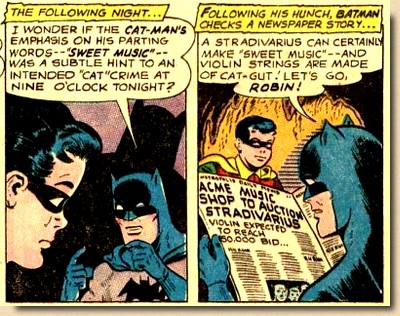 |
|
|
| |
| Meanwhile,
Batman is now certain that only Tom Blake can be the
Cat-Man, and together with Robin he drives to Blake's
animal farm where they find tracks of the Cat-Man's car
leading to an abandoned mine. Inside, what they first
perceive to be giant cat's eyes turn out to be lamps
illuminating the tunnel. Moving through these
"cat-acombs", they soon find themselves stuck
in a trap and held back by electrified steel bars. |
| |
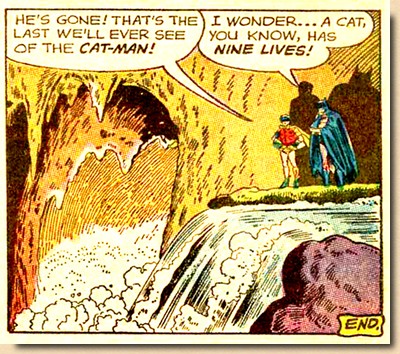
|
|
Whilst Blake
- aware that Batman has deduced
his identity - explains his
motives and operations over a
loudspeaker system, Batman knocks
out the electricity for the steel
bars with a batarang. Free to move
again, the Dynamic Duo storm
Blake's commando room - where
they find Cat-Man riding on and
operating a giant mechanical cat
with razor sharp claws. However,
Batman manages to stall the
machine and Cat-Man flees once
again.
This time,
however, he slips and falls into
an underwater stream running
through the old mine. Too late,
Batman and Robin are forced to
helplessly watch Cat-Man drown in
the turbulent waters - although
Batman does wonder about cats and
their legendary nine lives...
|
|
|
|
| |
REVIEW & ANALYSIS
Featuring an
outright corny and at times even whacky Batman story, Detective
Comics #311 actually is a surprisingly good and
entertaining read - surprisingly, because the early 1960s
Batman period was characterized by an increase in
stereotyped sci-fi scripts and an accelerated decrease in
plot and character interest - in 1963, no less than 10
stories featuring aliens appeared in Batman and Detective
Comics. As a consequence, reader interest in Batman
decreased rapidly and DC seriously contemplated dropping
the character - a move only prevented by then newly
appointed editor Julius Schwartz's last chance creation
of the "new look" Batman in May 1964 (Detective
Comics #327).
The story
told in Detective Comics #311, however, takes
place in an entirely different world - a world modelled
on the outward appearances of the real world, yet a world
entirely of its own and far removed from any semblance of
the inner workings of the real world. It is a world so
theatrically staged that there can be no doubt - as a
reader, you are no part of this play, you are only
following it as a spectator.
It is the
Batman world of oversized props where seemingly every
shop stocks a giant version of whatever product it sells,
and it is the Batman world of zany characters who, more
than anything, act in accordance with their
"theme". The Batman television show is still
some three years away at this point, but Detective
Comics #311 is an early impression of what a
"campy" Batman adventure could look like. As
such it is rather well executed and in spite of the
ridiculously exaggerated "cat theme" Bill
Finger actually manages to deliver a well-paced and
rounded off story. Feline references and word games chase
each other in amazing numbers and a regular flow, and
most of it works fine for readers who can take the odd
punch at real world logic as being tongue in cheek.
|
| |
| This is also a time
when Batman is quite happy to visit a
museum in his costume as a guest of
honour and even more than happy to share
his immense knowledge and lets us know,
for example, that a hoist-rope - used by
Cat-Man to escape from Gotham Museum - is
called a "cat-line" in oil
field slang, or that "boma" is
a Swahili word to describe a stockade
used as a protection against wild lions. A
quick check on the world wide web these
days confirms in a flash that Bill Finger
got all of that right, but back in 1963
one can assume that Finger must have
spent quite some time assembling all of
this "cat-related" information.
Even though Detective
Comics #311 clearly has no other
ambition than to entertain, the creative
team cut no corners in achieving this,
and arriving there did not come cheaply
either in terms of time and efforts
spent.
|
|
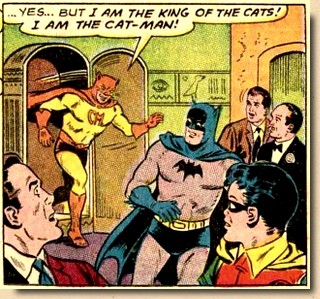
|
|
|
| |
| Even more
so as it was also a time when Batman's adversaries had
taken on the Riddler's cue and were constantly throwing
mysteriously worded clues for their next "themed
crime" at Batman with one simple message - go
figure! And if the ending seems rather harsh
with Cat-Man supposedly drowning - well, Batman's musings
will prove to be spot on only seven more months into 1963
when the Cat-Man returns alive and well in Detective
Comics #318.
|
| |
| VERDICT:
SUGGESTED
READING -
A nice and entertaining early 1960's Batman story
- in spite (or because?) of a nice collection of
nonsensical props and machinery which defy all
common sense and logic. |
|
| |
TRIVIA
The
first Cat-Man story has not been reprinted since its
original publication, and it carries no credits for the
creative team - only after Bob Kane signed a new contract
with DC in August 1968 did Batman artists get full credit
in the comic books.
|
| |
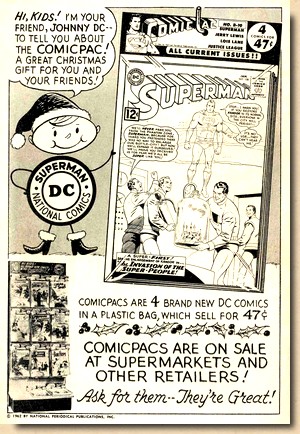 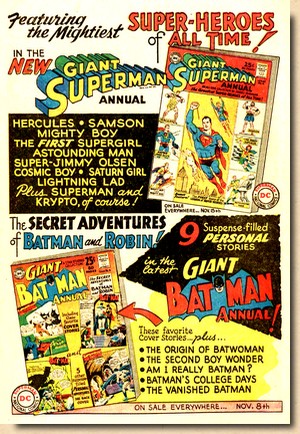 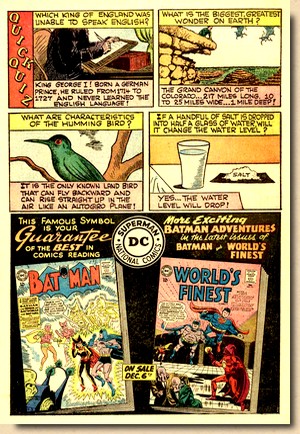 |
| |
| Detective
Comics #311 featured several
in-house ads, including teasers
for the currently on sale or
upcoming issues of Batman,
World's Finest, and Detective
Comics (all of which, of
course, featured the Caped
Crusader). One entire
page was dedicated to drumming up
attention for the Batman
and Superman Giant
Annuals, while the inside front
cover introduced readers to the
(at the time) all-new "comicpacs" which
contained 4 current DC titles
packaged in a sealed plastic bag
and sold at outlets which didn't
usually stock comic books, such
as supermarkets and retail
stores.
|
|
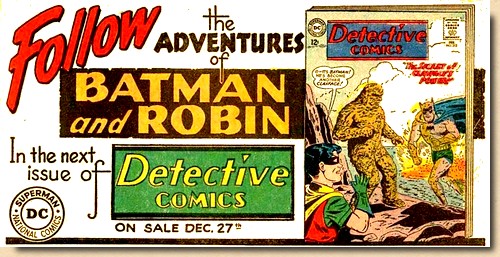 |
|
|
|
| |
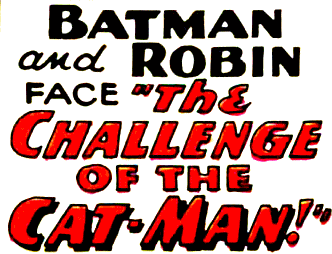
|
| |
SPOTLIGHT ON
THE CAT-MAN
|
| |
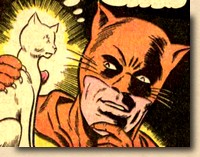 |
|
IDENTITY -
Thomas Blake FIRST
APPEARANCE -
Detective Comics #311 (January 1963)
CREATED BY -
Bill Finger & Jim Mooney
CHARACTERIZATION - A
marginal gimmicked villain
|
|
|
| |
ORIGIN
Thomas
Blake, a millionaire and world-famous trapper of jungle
cats, turned to crime after losing his fortune and
growing bored of hunting.
|
| |
| Basically copying
Catwoman's burglaries, Blake also
modelled his costume after her disguise
and adopted the name Cat-Man - none of
which made Selina Kayle a.k.a. Catwoman
too happy. Thus being
essentially a copycat (feline references
again), Blake does have a special aspect
which clearly sets him apart from
Catwoman: his cape, which is made of an
African cloth. This was shown to have
some very special characteristics when
Catman returned in Detective Comics
#325 (March 1964) from what had seemed
certain death in Detective Comics
#311 - in fact, the orange fabric in his
uniform seemingly gave him nine lives.
As is the case with
many Batman villains introduced in the
early to mid-1960s, Cat-Man was
originally presented as a gimmicked
villain following the theme reflected in
his name - Cat-Man thus operates on a
strong (and at times way-out)
"cat" theme by initially only
stealing items with a material reference
(such as cat statues) or an alluded
quality reference (such as precious
emeralds taken to be "cat's
eyes") - and even riding a
mechanical cat as depicted on the cover
of Detective Comics #311.
|
|
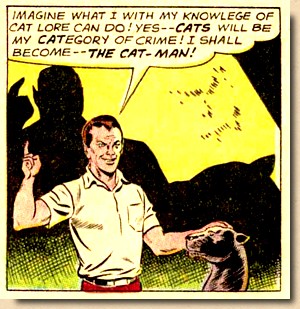
|
|
|
| |
| Having
originally been a big game hunter, Blake is a highly
trained athlete and a skilled hand-to-hand combatant, all
of which he uses in conjunction with his extraordinary
sense of smell when operating as Cat-Man. His weapon of
choice, however, are a pair of steel razor-tipped gloves
("claws") and a sharp-edged
"Catarang", which clearly is modelled after
Batman's very own Batarang. Following his initial
appearances, the character became less clear-cut and at
times drifted more towards being an anti-hero than a true
villain.
|
| |
APPEARANCES
|
| |
| Cat-Man
originally appeared in 3 issues of Detective Comics in
1963/64 before being put into storage. He enjoyed
something of a comeback in the early 1980s when writer
Gerry Conway was looking at the repertoire of Batman's
Golden and Silver Age villains which had become more or
less forgotten in most cases. |
| |
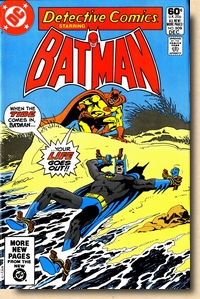 |
|
However,
Cat-Man's appearances in the two main titles of
the Batman Universe have remained limited,
although the character remains in use today
(albeit outside the core Batman Universe):
Detective Comics #311
(January 1963)
Detective Comics #318 (August 1963)
Detective Comics #325 (March 1964)
Batman #322 (April 1980)
Batman #323 (May 1980)
Batman #324 (June 1980)
Detective Comics #509 (December 1981)
Detective Comics #526 (May 1983)
Batman #371 (May 1984)
Detective Comics #538 (May 1984)
Batman #400 (October 1986)
Detective Comics #612 (March 1990)
|
|
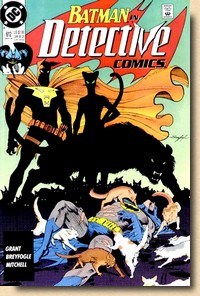 |
|
| |
| In 1992 Cat-Man made an
appearance in Shadow of the Bat as a member of a
team called the "Misfits", portrayed as a group
of C list villains who were trying to prove themselves;
Cat-Man also featured in the 1995 Shadow of the Bat
/ Catwoman crossover in which the background story
concerning the cloth of Cat-Man's costume was retconned
and depicted as having come from a South Sea cat cult
from which Catwoman, through trickery, obtained the
cloth. Following these
brief appearances, Cat-Man remained in limbo until 2003,
when he changed the locale of his prowlings and
resurfaced as a foe of Green Arrow; later on, in 2005, he
featured in a mini-series (Villains United).
Cat-Man made his New 52 debut in December 2014,
with a completely changed outfit, in DC's reboot of the Secret
Six.
|
| |

|
| |
BATMAN and all
related elements are the property of DC Comics,
Inc. TM and © DC Comics, Inc., a subsidiary of
Time Warner Inc.
The illustrations presented here are copyright
material. Their reproduction for the review and
research purposes of this website is considered
fair use as set out by the Copyright Act of 1976,
17 U.S.C. par. 107.

(c) 2016
uploaded to the web 1
June 2016
|
|
|

















